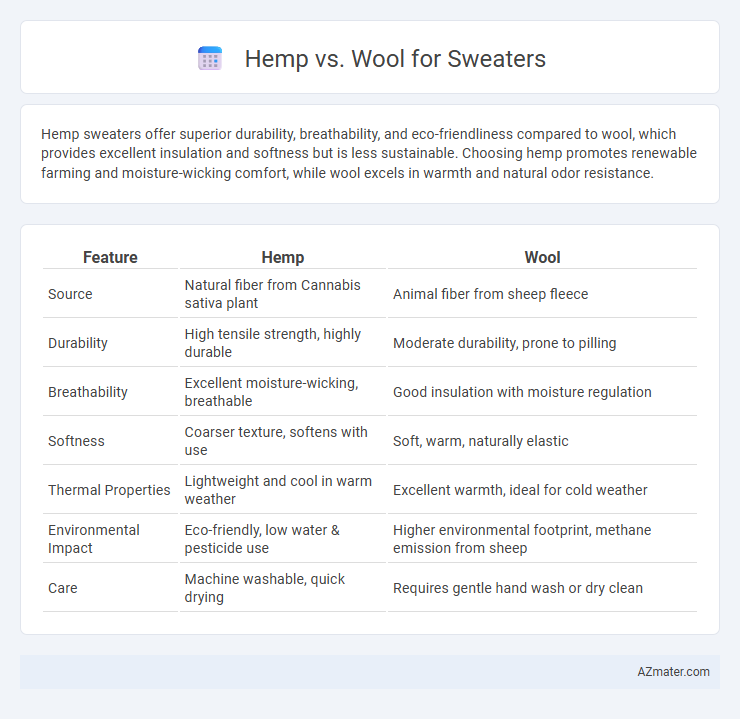Hemp sweaters offer superior durability, breathability, and eco-friendliness compared to wool, which provides excellent insulation and softness but is less sustainable. Choosing hemp promotes renewable farming and moisture-wicking comfort, while wool excels in warmth and natural odor resistance.
Table of Comparison
| Feature | Hemp | Wool |
|---|---|---|
| Source | Natural fiber from Cannabis sativa plant | Animal fiber from sheep fleece |
| Durability | High tensile strength, highly durable | Moderate durability, prone to pilling |
| Breathability | Excellent moisture-wicking, breathable | Good insulation with moisture regulation |
| Softness | Coarser texture, softens with use | Soft, warm, naturally elastic |
| Thermal Properties | Lightweight and cool in warm weather | Excellent warmth, ideal for cold weather |
| Environmental Impact | Eco-friendly, low water & pesticide use | Higher environmental footprint, methane emission from sheep |
| Care | Machine washable, quick drying | Requires gentle hand wash or dry clean |
Introduction: The Battle of Natural Fibers
Hemp and wool represent two of the most sustainable natural fibers used in sweater production, each offering unique benefits for warmth and durability. Hemp fibers are highly breathable, moisture-wicking, and resistant to mildew, making them an ideal choice for eco-conscious consumers seeking lightweight yet tough fabrics. Wool, derived from sheep, provides exceptional insulation and elasticity, maintaining heat even when wet, which is crucial for cold-weather apparel.
Sustainability: Hemp vs Wool Environmental Impact
Hemp requires significantly less water and pesticides compared to wool production, making it a more sustainable crop for sweater manufacturing. Wool production involves raising sheep, which contributes to methane emissions and land degradation, whereas hemp cultivation enhances soil health and carbon sequestration. When evaluating environmental impact, hemp sweaters offer a lower carbon footprint and reduced ecological strain relative to traditional wool garments.
Comfort and Breathability: Which Fiber Wins?
Hemp fibers offer superior breathability, allowing moisture to evaporate quickly and keeping the wearer cool and dry, ideal for those prone to overheating. Wool excels in temperature regulation, providing warmth without overheating due to its natural crimp that traps air, while also wicking moisture away from the skin. For comfort, hemp's smooth texture feels lighter and less itchy compared to the sometimes coarse fibers in wool, making hemp a better choice for sensitive skin and warm weather sweaters.
Insulation and Warmth: Hemp or Wool for Cold Weather
Wool outperforms hemp in insulation and warmth for sweaters, as its natural crimp traps air effectively, providing superior thermal regulation in cold weather. Hemp fibers, while breathable and moisture-wicking, lack the loft necessary to retain heat as efficiently as wool. For optimal cold weather protection, wool remains the preferred material due to its high insulating properties and ability to maintain warmth even when damp.
Durability: How Long Do Hemp and Wool Sweaters Last?
Hemp sweaters exhibit exceptional durability due to their strong, resilient fibers that resist wear and tear, often lasting over a decade with proper care. Wool sweaters, known for their natural elasticity and insulating properties, typically endure 5 to 10 years but may experience pilling and stretching over time. Both materials offer long-lasting options, with hemp surpassing wool in resistance to abrasion and moisture degradation.
Care and Maintenance: Washing Hemp vs Wool
Hemp sweaters require gentle washing in cold water with mild detergent to preserve fiber strength and prevent shrinkage, and they dry quickly without needing excessive care. Wool sweaters demand hand washing or machine washing on a wool-specific cycle with cold water and specialized wool detergents to avoid felting and maintain softness. Proper drying for wool involves flat drying away from heat sources to retain shape, while hemp's robust fibers tolerate air drying with less risk of distortion.
Allergenicity: Sensitive Skin and Fiber Choices
Hemp fibers exhibit low allergenicity due to their natural resistance to mold, mildew, and dust mites, making hemp sweaters ideal for sensitive skin. Wool, while warm and durable, can cause irritation or allergic reactions in individuals prone to lanolin sensitivity or wool itch. Choosing hemp over wool ensures a hypoallergenic option with breathable, moisture-wicking properties that reduce skin irritation and promote comfort for allergy-prone wearers.
Ethical Considerations: Animal Welfare vs Plant-Based
Hemp sweaters offer an ethical advantage by being plant-based, requiring no animal exploitation and promoting sustainable farming practices that use less water and pesticides than traditional wool production. Wool sweaters, although biodegradable and renewable, involve animal welfare concerns due to practices like mulesing and intensive sheep farming, which can cause stress and harm to sheep. Choosing hemp supports cruelty-free fashion aligned with eco-conscious consumer values seeking to minimize environmental impact and animal suffering.
Style and Aesthetic Differences
Hemp sweaters offer a natural, rustic texture with a matte finish that appeals to eco-conscious fashion enthusiasts seeking a casual, earthy aesthetic. Wool sweaters provide a classic, refined look with a soft, plush surface that enhances formal and traditional styles. The drape of wool tends to be more fluid and luxurious, while hemp delivers a structured silhouette ideal for rugged, minimalist fashion statements.
Cost Comparison: Hemp Sweaters vs Wool Sweaters
Hemp sweaters generally cost less than wool sweaters due to lower raw material expenses and sustainable farming practices. Wool sweaters, especially those made from high-quality merino or alpaca fibers, tend to be more expensive because of labor-intensive shearing and processing methods. Consumers seeking budget-friendly options often prefer hemp sweaters for their durability and eco-friendly attributes without compromising on warmth.

Infographic: Hemp vs Wool for Sweater
 azmater.com
azmater.com